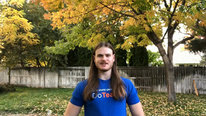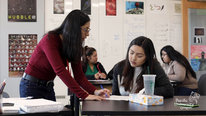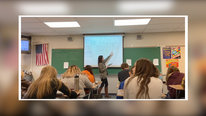- Seema Rivera
- Assistant Professor of STEM Education
- Presenter’s NSFRESOURCECENTERS
- Clarkson University
- Jan DeWaters
- Associate Professor STEM Ed/Engineering
- Presenter’s NSFRESOURCECENTERS
- Clarkson University
- Ben Galluzzo
- https://www.clarkson.edu/people/benjamin-galluzzo
- Associate Professor
- Presenter’s NSFRESOURCECENTERS
- Clarkson University
- Katie Kavanagh
- Professor of Mathematics
- Presenter’s NSFRESOURCECENTERS
- Clarkson University
- Michael Ramsdell
- Associate Professor of Physics
- Presenter’s NSFRESOURCECENTERS
- Clarkson University
STEM Up NY
NSF Awards: 1852820
2021 (see original presentation & discussion)
Grades 9-12, Graduate
This video from Clarkson University's Noyce Program (STEM Up NY) will share how our math and science preservice teacher-scholars addressed equity and adapted to teaching during the time of COVID. Our scholars are secondary preservice math and science teachers and complete a one-year residency in the same secondary school for the duration of the year. The STEM Up NY MAT model will also be shared.
Mathematics, Science, Broadening Participation
Clarkson University
Robert Noyce Teacher Scholarship Program (NOYCE)
Related Content for STEM Up NY: Clarkson University Noyce Scholars Program
-
 2016Recruiting STEM Teachers: UT Tyler UTeach
2016Recruiting STEM Teachers: UT Tyler UTeach
Michael Odell
-
 2021Boise State Noyce Scholars' Service at a Distance
2021Boise State Noyce Scholars' Service at a Distance
Jan Smith
-
 2020STEM Integration through an Engineering and PBL Partnership
2020STEM Integration through an Engineering and PBL Partnership
Christine Lotter
-
 2020Supporting PBL Instruction on the US-Mexico Border
2020Supporting PBL Instruction on the US-Mexico Border
Amy Wagler
-
 2019Meet Denise Aquino, Pacific Noyce Scholar
2019Meet Denise Aquino, Pacific Noyce Scholar
Kevin Carr
-
 2020VolsTeach for Appalachia: Becoming a STEM teacher
2020VolsTeach for Appalachia: Becoming a STEM teacher
Nick Kim
-
 2021Noyce Capacity Building Project at Bellarmine University
2021Noyce Capacity Building Project at Bellarmine University
Kristin Cook
-
 2021Lessons Learned by STEM Master Teachers from the Pandemic
2021Lessons Learned by STEM Master Teachers from the Pandemic
Raffaella Borasi
This video has had approximately 154 visits by 133 visitors from 88 unique locations. It has been played 61 times as of 05/2023.
Map reflects activity with this presentation from the 2021 STEM For All Video Showcase website, as well as the STEM For All Multiplex website. 
Based on periodically updated Google Analytics data. This is intended to show usage trends but may not capture all activity from every visitor.
Playlist: Sharing lessons learned from COVID …
Sharing lessons learned from COVID moving forward in K-12 STEM
Playlist for meetup held on June 23, 2021.
-
 2021Lessons Learned by STEM Master Teachers from the Pandemic
2021Lessons Learned by STEM Master Teachers from the Pandemic
Raffaella Borasi
-
 2021STEM Up NY: Clarkson University Noyce Scholars Program
2021STEM Up NY: Clarkson University Noyce Scholars Program
Seema Rivera
-
 2021teachHOUSTON STEM Interactive: STEM Accessible Worldwide
2021teachHOUSTON STEM Interactive: STEM Accessible Worldwide
Paige Evans
-
 2021Virtual professional development for community educators
2021Virtual professional development for community educators
Sue Allen
-
 2021STEM Master Teachers Emerging as Leaders during the Pandemic
2021STEM Master Teachers Emerging as Leaders during the Pandemic
Zenon Borys
show more
Discussion from the 2021 STEM For All Video Showcase (13 posts)





Seema Rivera
Assistant Professor of STEM Education
Hi Everyone, I'm Seema Rivera, the PI for Clarkson University's first Noyce Program! We are just finishing up our second year of a 5-year program. Our program covers senior year and the Masters of Arts in Teaching (MAT) year. We are investigating how to prepare science and math preservice teachers to be culturally competent to teach in both rural and urban schools. We certify in secondary math, physics, chemistry, biology, earth science, technology, and computer science.
I look forward to your comments and questions!
Catherine Horn
Meghan Marrero
Pendred Noyce
Great work! (I'm always touched by Noyce Scholars programs since they are named after my father.) I'm intrigued by what the young scholars have to say about teaching remotely, how to keep kids active and engaged. I recommend the book Ten Big Bets by my friend Gil Noam as a thought-provoking guide to rethinking school after COVID. Also, based on my own interests, a question: do you give any thought to including literature in science class? Or writing? And to what extent do the scholars try include personal and societal concerns and decision-making with the young people they are teaching?
Cathy Lussier
Lisa Lamb
Catherine Horn
Meghan Marrero
Seema Rivera
Seema Rivera
Assistant Professor of STEM Education
Thank you, Pendred, I will check that book out! Yes, one of our students this year used literature and stories to teach science, we have not done as much with writing but I think that is something we need to focus on. Being able to communicate work, regardless of the discipline, is key so I will definitely be looking into that more in the future (writing/communication in stem). I think the nature of science aspects you touched upon (the person and societal concerns) is a great way to engage students in stem...I hope our scholars continue to build on what they have learned so far with regard to the nature of science.
Catherine Horn
Meghan Marrero
Great video, Seema! For me, I think that leaning on culturally relevant pedagogies will help novice teachers to meet the needs of their learners, regardless of the context.
Seema Rivera
Christine Royce
Professor
Nice job Clarkson University! - The transition to digital online teaching was challenging for experienced teachers and I am sure the preservice teachers in your program as well. It sounds as if there were many different adaptations that were made ranging from the type of digital tools used to the structure of the class period that was offered. How had technology and the use of these digital tools been incorporated into coursework pre-pandemic? Have any decisions related to future coursework or focus been discussed yet to include tools such as these if they weren't previously part of the program?
Christine
Catherine Horn
Catherine Horn
Moores Professor and Chair
Thanks, so much, for the great introduction to your program! The video left me with several wonderings. I loved that one of the participants described the needed approach to thinking/rethinking instruction during the pandemic as "approaching it like a science project." Great and positive reframe! Building on Christine's question, what have you learned throughout this year that you see as critical to success that has changed the ways in which you think about successful teaching and learning?
I also wonder, in a different aspect of the program, how you arrive at the action research areas of focus. Are these collaboratively identified or predetermined based on instructional goals? Finally, I'd love to know more about the characteristics and process you use to identify "highly qualified" mentor teachers.
Appreciate your work!
cathy
Jill Berg
Leadership Coach, School Improvement Consultant & Author
This video highlights one of the important ways this pandemic crisis offered an opportunity: It opened teachers up to trying new practices and offering more choices, especially ones that expanded differentiation through technology. Next, we should be thinking about how teachers are coaching students to be skillful choice-makers, so that each choice helps them to become effective as independent learners.
Audrey Cohan
Great work! Thank you for sharing this video and offering examples as to best practices. It was good to hear that your teacher candidates were hired despite the pandemic. How do you recruit your Noyce scholars from under-represented populations?
Jan Smith
You have a very similar Noyce focus to ours; we are also targeting rural students who want to return to their home communities to teach. This past year has been a very challenging year for teachers; your scholars have shown amazing flexibility, creativity, and adaptability. If they can get through this year, they can do anything!
Seema Rivera
Audrey Cohan
We agree that a "grow your own teacher" approach is a wonderful idea as candidates return to their home communities. Thanks for sharing and keeping the conversation going!
Seema Rivera
Sabrina Stanley
Yes! Flexibility, creativity, and culturally responsive engagement are critical factors for our STEM teachers and students, especially this past year. Thank you for pointing out that all the students struggled with extended screen time and engagement during the Pandemic. You and your fellows have undoubtedly done great work! Thanks for sharing.
Tracey Sulak
We have a newly-developed MAT but no scholarships offered. Our students typically come from our biology department, but we have not had any luck recruiting them through typical means (large group presentations, town halls, etc). The majority of our candidates come from our iBEARS program where they served as mentors to 4-8th grade students. That is not a very large pool! Any ideas of how to expand this group without offering scholarships?
Cathy Lussier
Thank you for sharing this video. I really enjoyed hearing from your student scholars. I'm so glad to hear that your teacher candidates were hired despite the pandemic, our Noyce scholars were too. I liked that your student scholars talked about using the physical aspects (whiteboards and the like) to help maintain engagement to adapt during the online drift that seems to happen. That was great that you were able to keep action research still in your study this year despite COVID.
Further posting is closed as the event has ended.